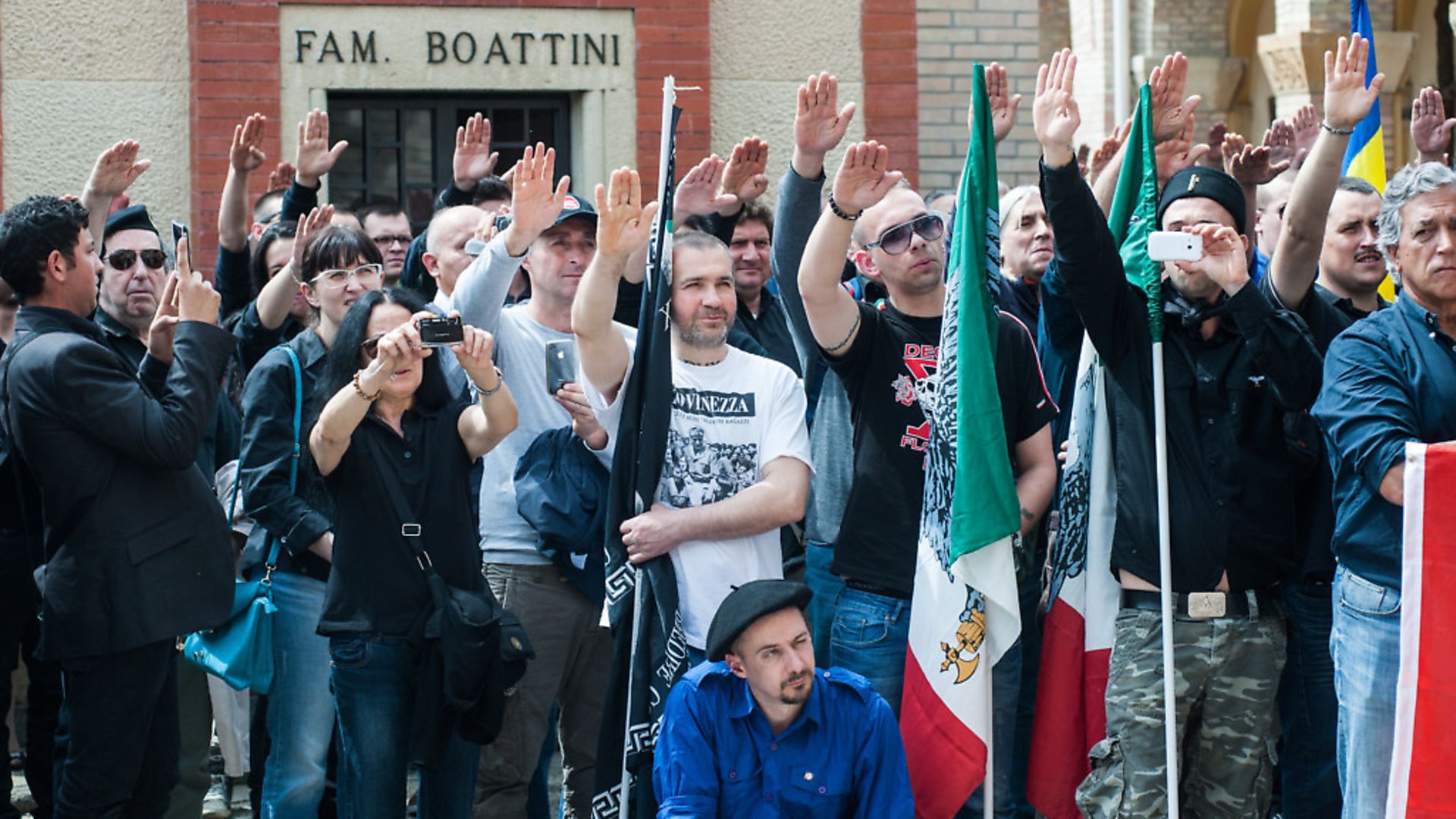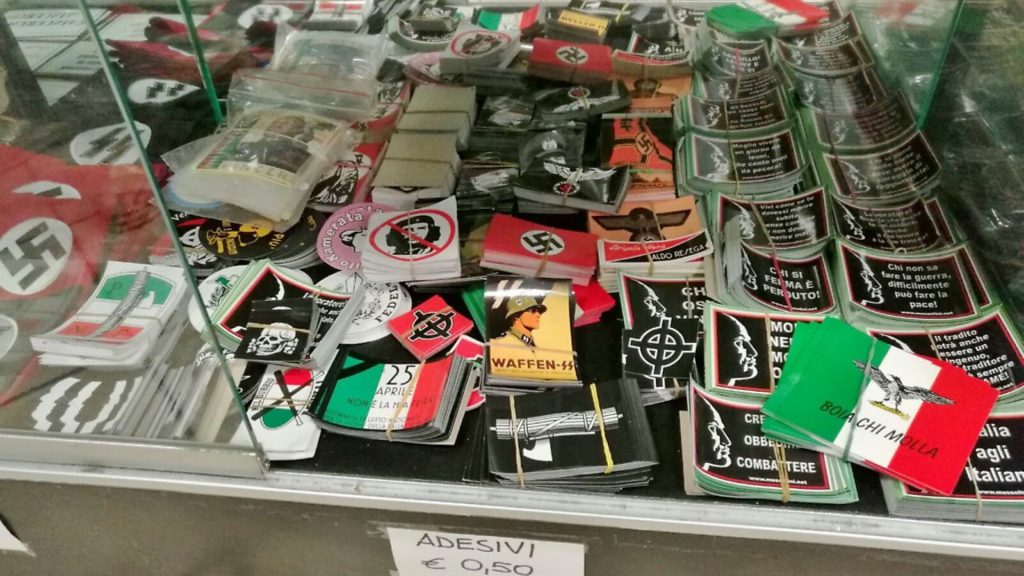
Nowhere better captures Italy’s complex relationship with fascism than Predappio, the birthplace of Mussolini. CLARE SPEAK paid a visit

The sunlit Piazza Sant Antonio in Predappio sits in front of the church of the same name. On most days it is a peaceful square in what looks at first glance to be just another pretty Italian town, surrounded by rolling countryside of Emilia-Romagna.
But on the day I arrive the square is packed with hundreds of neo-fascist demonstrators. The dress code is entirely black, and the mood is reverent, with sporadic chants of ‘duce, duce, duce’ rising from the crowd, waiting in the spring sunshine for the procession to begin.
Italy’s neo-fascists are arriving by the busload, coming to the far-flung town in Italy’s hilly northeast on a kind of pilgrimage. They will march a mile from the square to the San Cassian cemetery, to visit the tomb of Benito Mussolini, who was born here in Predappio and is now buried in his family’s crypt.
Such rallies, complete with banners, Roman salutes and prayers led by a defrocked fascist priest, can attract thousands of people. They’re held here three times a year; to mark the date of the Italian dictator’s birth on July 19 in a house in the town, his death, on April 28 (the time of my visit) at the hands of partisans in the north, and again in October, to commemorate the fascist party seizing power in 1922.
Many of those drawn here, say they are nostalgic for a time when, they say, Italy stood for something.
‘The politicians of today are a joke, and they’re making a joke of our country,’ said Andrea Sartori, a former soldier who had travelled from Veneto, to the town. ‘This is why the establishment has been kicked out.’
He is referring to Italy’s recent elections in which the established parties of the right and the left took a battering, as angry voters abandoned them in favour of the insurgent right-wing Lega and the populist Five Star movement, protesting against high taxes, high unemployment and corruption.
Two months on, Italy is still without a government. Lega is claiming it has the right to choose the next prime minister, as part of a right-wing coalition that drew nearly 40% of the vote. Not enough for a majority, but a clear indication of public opinion.
Debate rages in Italy about whether there is any overlap between the anti-immigrant Lega and Italy’s fascist past, and if so, where it lies. A gunman who shot at six African migrants during a rampage in the central town of Macerata (and gave a fascist salute as he was detained) in February had stood as a Lega candidate the year before. But the party rejects any suggestion of links to fascism.
In Predappio, though, there is no mistaking the still-visible stain of the past. Here, Mussolini’s shadow hangs heavily. Not only was the dictator born and buried in Predappio, but the entire town was rebuilt under his instructions.
As well as the church, the square of Sant Antonio is flanked by a small hospital and a police station, all designed to be part of the ‘ideal’ 1920s Italian town envisaged by the fascists. Nearby, neat blocks of small houses are lined up like army barracks on a perfect grid. All were designed and built to Mussolini’s specifications, with architect Florestano Di Fausto overseeing the work.
The main square is overlooked by the compact, pastel-hued Palazzo Varano, which today is the town hall. It is one of many former Mussolini residences, but is now occupied by a centre-left mayor, Giorgio Frassineti of the Partito Democratico (PD). The sloping, manicured garden leading from the square up to the town hall is closed off on the weekend of my visit, apparently for maintenance. Its centrepiece is a memorial to the victims of fascism.
To the side of the carefully maintained town hall garden sits the abandoned and crumbling Casa del Fascio, or House of Fascism. Mussolini ordered 11,000 of them to be built in Italy between 1922-1942.
The large building, where party members once held dances, and speeches were given from the balcony, now stands forlorn. Its tower is crumbling, a tree sprouting sideways from one broken window.
Frassineti talks of converting it into an educational Museum of Fascism. But many in the town fear it would just become another attraction for fascist visitors, and with no funds for the project available, the building continues to rot.
A group of local residents at a nearby café tell me that for them, the building has no significance any more and may as well be torn down.
‘It means nothing now.’ shrugged one customer, Giorgio, as other patrons murmured in agreement.
They have the same ambivalent attitude towards the throngs of neo-nazis in the streets, marked with swastikas and other symbols of hate.
‘These are just symbols. Mussolini and Hitler are dead,’ says Giorgio. ‘If people want to wear that rubbish, they can.’
They have the same attitude towards the town’s ghoulish souvenir shops. I find one such shop packed with black-clad customers and piled high with flags, right-wing literature, and everything from mugs and fridge magnets to knives featuring skulls, swastikas, or Mussolini’s glowering face. There’s a tea set featuring SS insignia, and what is purported to be ‘Mussolini’s original writing desk’, a small and shabby specimen.
The authorities closed down these shops in 2009, with councillors saying they were tarnishing the town’s image. But within a couple of years they were back in business.
‘This shop was never closed down by the authorities. That’s just hearsay,’ one staff member says, offering me a glass of San Giovese from a bottle emblazoned with the crest of the deadly Flottiglia Decima Mas, an elite Second World War naval unit. Behind me, a family are choosing a T-shirt for their toddler from a selection emblazoned with quotes such as Italia agli Italiani (‘Italy for the Italians’).
The startling thing about this Italian brand of neo-fascism is how brazenly and casually it is displayed. Much like the copies of Mein Kampf in the shop window, there’s no sense that it needs to be kept out of sight.
The dictator may be long dead but his ideas clearly are not. Some say that in Italy, fascism never truly went away. And traces of that era’s legacy linger, not only on the fringes of society but right at its heart, echoing in everything from Italy’s university life to its public services.
Several universities, such as Foggia, are known for having sizeable right-wing student organisations, which flourish unchecked. Meanwhile, firefighters describe basic training exercises that include climbing a tower and performing the Roman salute upon reaching the top, a fascist-era practice left unquestioned and still waiting to be abolished. The country is still peppered with landmarks and memorials to the dictator, and there’s little appetite to remove them.
Ambivalence, and even resigned acceptance, seems to be the prevailing attitude in Italy towards not only these relics but to the continued presence of the far-right.
And that feeling extends to Mussolini himself. Talk of the dictator’s two ‘mistakes’ – creating racial laws and joining the war – is rife, as is talk of his many alleged merits and contributions to Italian society. Former president Berlusconi praised Mussolini for his contributions in 2013.
In general though, Italians tend to look at things from both sides, as evidenced by the still-common refrain of quando c’era lui i treni arrivavano in orario – ‘at least he made the trains run on time’. And this even-handed attitude doesn’t look set to change any time soon. Even in popular culture the dictator is given a surprisingly easy ride.
Recent film Sono tornato (‘I’m back’), a comedy imagining the return of Mussolini to present-day Italy, was well-received.
‘Mussolini completely changed Predappio. He built a completely new town here where before there was just a road with ten houses,’ says local resident Roberto Fabbri, standing in the middle of the Piazza Garibaldi, a grand, semicircular market square designed in 1928 to enhance the space below the house where Mussolini was born. ‘Say what you like. But all this was thanks to him.’
In Predappio, after the rally has ended and the coachloads of neo-fascists have left, life goes on as normal. But its place at the heart of Italy’s fascist movement means it will never be a town just like any other.
Clare Speak is a freelance journalist based in Arezzo, Italy. She can be found on twitter @ClareSpeak









